Pipe Down!
As the trend towards high density living continues on an upward curve, acoustic consultants are under constant pressure to ensure noise pollution remains at a minimum. While some consider it outdated, pipe lagging is still the most specified solution to combat plumbing noise because quite simply, it works. Justin Felix explains.
It’s a sound we could all go without; the funnelling of wastewater rushing through pipes in our walls. As the water passes through, noise reverberates out into the habitable space and fills the room. You curse the person who instigated the water being passed through as it knocks you out of the slumber you gently fell into after hours of restlessness.
It doesn’t have to be this way though, for you or your clients.
You may recall that in the winter edition of 2014, Plumbing Connection looked at three systems that aimed to make plumbing a whole lot quieter while making lagging a thing of the past. By using advanced materials in their acoustically sound piping systems, the Silere and Triplus from Valsir, RAUPIANO PLUS and Wavin AS systems all removed the need for external lagging of the pipe work.
Basically speaking, all three systems comprised of self-sufficient pipes, each of which has started to make their name known among Aussie specifiers and installers.
With this being said though, the vast majority are still putting their faith in the traditional approach, being lagging. This is where we focus our attention this time around.
NOISE POLLUTION
Waste systems are generally taken for granted. They’re a mere afterthought in the minds of residents. That is until they can hear them and become affected by the constant noise generated inside the pipelines.
Plumbing noise is one of the most intrusive and difficult sounds to mitigate. In many people’s eyes, varying levels of plumbing noise are expected and tolerated without complaint. Most often, the noise generated within a tenant’s own space and resulting from one’s own use of plumbing fixtures isn’t given much thought. On the other hand, when plumbing noise is a result of an adjoining space and results in sleep disturbance or interruption of peace and quiet, it quickly becomes an annoyance.
Unfortunately, pipework can operate as a major conduit for noise to travel from one part of a building to another. Most of the generated noise spreads inside the pipe (air-borne noise) but the vibrations caused are then transmitted from the walls of the pipe to the surrounding area and bracketing systems. This in turn transmits to the building structure (structure-borne noise).
To minimise noise levels in waste and drainage systems, not only should the system be designed properly and the waste circuit mounted correctly, it is also important to choose a system with an elevated soundproofing performance. Acoustic plumbing aims to combat the issue of internal noise pollution and a number of companies have developed products to tackle the problem head on.
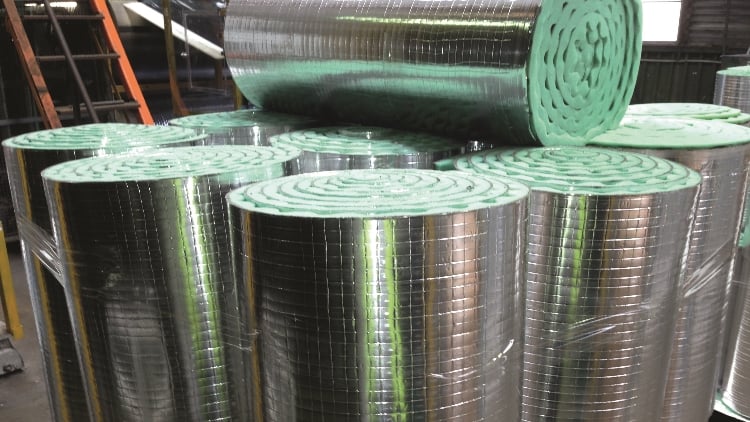
The thing to remember is, it does not have to be difficult or expensive. Recent advancements regarding the availability of products and support services now make the reduction of plumbing system noise easier, more effective and more affordable than ever before.
“On average, lagging costs around $20pm2. I’m sure plumbers like the idea of not having to lag pipes and would prefer to use pipes that are self-sufficient but lagging has proven itself as effective for decades. At the moment acoustic consultants are still specifying lagging over the newer technologies – especially in residential developments. Lagging is a critical part of residential buildings and at the moment we aren’t designing any without it,” says Olivier Gaussen, Principal, National Acoustics Coordinator, Wood & Grieve Engineers.
“There is no compulsory NCC requirement for plumbing acoustics for commercial buildings. The performance of pipes, lagging and silent pipes as far as acoustics are concerned in hydraulic systems, is only relevant to residential and aged care facilities.”
In other buildings, the driver for minimising noise output from pipes comes down to developers wanting to please the actual end users.
Olivier explains that in days gone by, people were happy for downpipes to run externally, down the walls of their homes. Now the architects are under increasing pressure to hide all services so the facade has a particular look. They must be aesthetically appealing.
“They have to conceal all the pipes within the building which creates challenges when it comes to keeping noise pollution to a minimum.”
Plumbing acoustics is a bit of a tricky area because it’s hard to demonstrate compliance or non-compliance as far as acoustics are concerned.
“The performance that the NCC nominates in residential and aged care facilities is an attenuation between the pipe and the middle into which the pipe will radiate noise i.e. a riser that is common to two apartments. This riser, including any lagging, will need to achieve a particular performance.
“From a wet area to a habitable area the code requires a greater performance than a wet area to wet area for instance. If you have a pipe in a ceiling cavity of a bedroom underneath a bathroom, the requirement is higher than if the space below a bathroom is another bathroom.
“The tricky part comes from the code saying that you need to attenuate the noise by a certain performance. The problem then occurs once it is installed as there is no physical way to test it. We can test the performance of the walls quite easily by putting a big speaker in one room with a device to calculate the sound coming through on the other side. We can’t put a speaker in a pipe though.”
Acoustic lagging comprises a noise barrier to contain pipe-wall vibrating noise. There are several types of materials used for this purpose, including loaded vinyl and convoluted foam. Each material will have a U-Factor, which is a performance rating that measures how well a given material prevents heat from escaping.
Let’s look at available products from three reputable Australian suppliers.
ACOUSTICA GREENLAG
GreenLAG® pipe lagging was developed to contain the intrusive noise generated by the turbulent flow of wastewater through pipes, fittings and general noise break-out from ductwork, fan housings and the like in residential, commercial and industrial buildings.
Philippe Doneux, Engineer at Acoustica describes some of the benefits of its product.
“GreenLAG uses a soft and cellular structure which increases vibration dampening. This allows for us to use 15mm foam as opposed to 25mm which most others use. It also means that for a given weight and thickness, GreenLAG will achieve a better STL (Sound Transmission Loss) than other products in the market.”
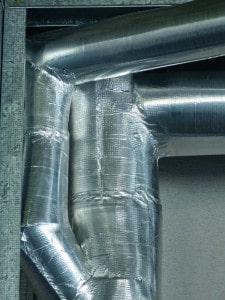
Acoustica also claim that another direct consequence of reducing material thickness is the reduction of the vibrations radiating surface, when lagged over pipe.
Pipe lagging has traditionally known to be laborious and time consuming; however Philippe believes this is changing thanks to experience and advanced skill sets.
“The professionals lag quite quickly now and teams of people exist who specialise in the field. These guys don’t need to take patterns to cut for different junctions and the like – they can do it all by eye now. It’s a bit like the old metal workers who could cut metal the right way.”
Keeping the installers happy by working into their regimes makes it all the more straight forward too.
“Depending on how the laggers like to have the material, we supply it in different lengths. There is a company in SA that uses women to do the lagging so they ask that the rolls of lagging are not overly heavy. We provide them with 3m lengths by 1.3m wide. We can supply in longer rolls up to 5m by 1.3m wide as well. We’ve definitely noticed a shift to shorter rolls though. It makes for easier navigation through stairwells and other tight spaces.”
When it comes to installation, Philippe assures that working with GreenLAG is simple and straightforward.
“It’s very easy to cut with a knife or scissors, particularly with the thinner material being employed. We suggest to installers that they always overlap by about 50mm rather than butt joining the material. We also suggest they use a longitudinal reinforced aluminium tape that goes over the seam every 350-400mm. It’s important that they wrap tape all around the pipe and back over itself because the memory of the material means it tends to want to roll flat again. The more tape, the better because once the ceiling is fitted you can’t see if it’s unravelled or not and by then it’s generally too late.”
THERMOTEC NUWRAP 5
Thermotec has been manufacturing both thermal and acoustic products in Australia since 1987 and have garnered a reputation for supplying a competitive world class range of products.
One such product is NuWrap 5 which is trusted to exceed performance expectations, and designed to meet or exceed the Building Codes of the countries, states, provinces or industry categories where they are specified and installed.
Thermotec NuWrap 5 acoustic pipe and duct lagging is classed as a ‘one solution’ product that can be used either indoors or manufactured for use outdoors.
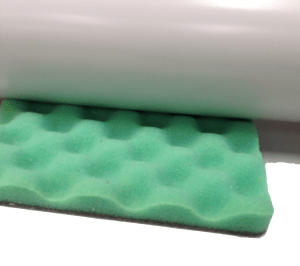
Performance is the result of using a special density convoluted foam in conjunction with a barium loaded, high mass, (5kg/m2) limp polymer material that is faced with a reinforced aluminium foil that gives the product additional strength as well as outstanding fire resistance characteristics.
When installing, the following steps should be taken:
– Cut insulation to suit either bends or straight lengths.
– Ensure that the outer pipe surface is clean and free of dust.
– Wrap insulation in place and ensure no gaps and that butt joins are well sealed. For straight lengths use a minimum 50mm overlap.
– Use 72mm wide foil face self-adhesive tape ensuring that surface to be taped is clean and dust free.
On straight runs, foil tape should be used as a band, wrapped around the insulation as well as along longitudinal joins. Joins should be facing downwards to avoid unnecessary weight and strain on the tape.
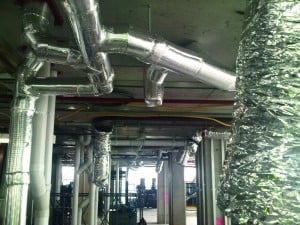
Check and double check there are absolutely no gaps in the joins.
PYROTEK NC SOUNDLAG4525C
A division of Pyrotek, Pyrotek Noise Control are continually working on new ways of tackling the problem of noisy environments. It is their ongoing goal to create advanced materials and innovative products which anticipate changing customer needs.
Soundlag 4525C is a pipe wrap comprising of 5kg flexible acoustic barrier bonded to 25mm thick flexible convoluted foam. The foam acts to provide acoustic decoupling between the pipe’s noise energy and the flexible acoustic barrier external wrap. The external face of the barrier is bonded to an aluminium foil providing a fire resistant covering.
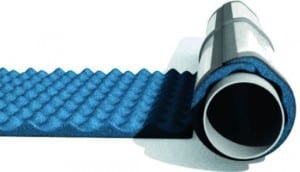
The specialist fillers create a heavy flexible mass barrier, maximising noise reduction. Soundlag’s uniquely flexible and naturally inert nature allows effective, easy installation, essential in achieving a noise-tight seal.
Pyrotek claim the flexibility of the polymer-based noise barrier provides superior performance and allows even the smallest pipes to be lagged effectively. It’s independently tested in laboratory conditions and on site to give proven consistent performance. Low maintenance with a long service life, the aluminium foil facing provides a robust lifetime by protecting external elements.
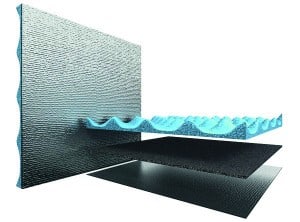
Pyrotek can provide pre-cut pieces for bends, junctions and floor waste gullies from templates upon request.
It’s time to turn down the volume.
